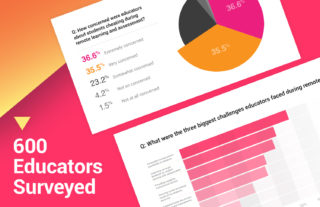What is a Benchmark Assessment System? What are the Benefits of Benchmarking in Education?


Benchmark assessment, also known as interim assessment, is a system used to evaluate the academic competency of a selected group of students. These academic evaluations help institutions and relevant educational agencies see if the evaluated students are on par with current grade standards.

An effective benchmark assessment system (BAS) can accurately determine which students need aid in a specific area of education (reading level, for example). In the process, benchmarking helps identify the best course of action required to remediate and boost student competency in this field of study.
With a proper BAS, an institution can quickly group their students by level of competency while informing their teachers on how to best interact with and help their assigned groups. Ultimately, this assessment will drastically raise academic performance across the entire student body.
What is Benchmark Testing In Schools?
Benchmark assessment is a technique used to evaluate student competency and performance in a specified area of study. Using this method, teachers can identify individual student behaviors and learning styles. Armed with this knowledge, staff members can implement the best guidance, learning techniques, and teaching styles to accommodate the students’ needs.
Many forms of interim assessment will also provide a BAS score. This data provides an effective way to group your students. These groups provide the optimal environment for these students to thrive.
Even before the testing is done, benchmark assessment creates an opportunity for teachers to hone in on their students’ specific skills. With proper focus and directed instruction, teachers can even help their students succeed in their initial assessments. In the long term, students and teachers will learn to work harmoniously, encouraging classroom order and academic performance.
What is the Purpose of Benchmark Assessment in Education?
A successful BAS provides several useful elements. These include the following:
- Identification of Student Comprehension
- Accurate Placement According to Needed Instructional Levels
- Planning for Successful Intervention and Teaching
- Additional Assistance for Struggling Students
- Periodical Student Assessment
- Evaluation of Success on an Individual and Group Level
- Teacher/Parent Communication
With these tools in hand, teachers and schools can engage more specifically with student learning needs. Students will be far less likely to fall behind when these intervention systems are used.
Structured and regular assessments can lead to observable and undeniable student growth. These systems will assess students throughout a given school year. This testing should be done with regularity, and if possible, timed with the content of a given curriculum.
Student assessment will provide crucial feedback regarding student learning. This data will aid in any necessary intervention plan. This information allows for easy tracking of individual growth while simultaneously observing the institution’s incremental improvement.
These interim evaluations will optimally focus not only on simple multiple-choice questions. Instead, other testing techniques such as experiments, multi-part questions, essays, and more can be used. These testing methods help provide insight into a student’s true comprehension and thoughts surrounding the assessed skills.
Benchmark Assessment Success Stories ~ The Benefits of Benchmarking In Education
These assessments have been helping struggling students for quite some time. This type of testing prevents individuals from slipping through the cracks and keeps them on track and advancing at an ideal pace.
In the United States, benchmark assessments have been used to gauge student comprehension accurately. Even in many cases where students have tested well via standard methods, accurate benchmarking can find weaknesses in understanding that may have been missed otherwise. Benchmarks have been applauded for their ability to promote reading and writing remediation, as well as improving other academic skills.
One heart-warming success story comes from Rimbey, Alberta, Canada. Jodi Bramfield, principal at Rimbey Elementary School, decided to implement a BAS in response to reports that many of her students had been struggling with literacy.
When the benchmarking system was implemented, the school discovered that many of their readers were indeed performing poorly. Fortunately, this assessment style provided accurate feedback, allowing the school to respond with further educational protocols for remediation.
Post evaluation and after implementing remedial techniques, the school saw a 64% increase in reading levels after eight weeks. This 64% of students increased their reading level by at least one, up to a maximum of six.
At the end of these eight weeks, 38% of the students were released from the program upon reaching the reading level appropriate to their grade. In short, the school experienced intensive and exponential growth.
How and When to Implement Interim Assessment?
Interim assessment (an alternative name for BAS) should be applied to broad portions of our student populations to ensure that no students are left without proper academic aid. The assessments can vary widely in their approach, although there are advocates who support one-on-one assessment prior to group placement.
Post evaluation, regular teaching/intervention should be provided to these groups. This should be a short-term (six to eight weeks average) and intensive program. In the example above, the school leveraged forty-five minutes of group work for eight weeks.
The proper grouping of students allows for many interactive learning opportunities. Teachers will receive support when creating structures and protocols to work efficiently with their selected students. Within this setting, students will have successful, first-hand learning experiences with both peers and school staff.
Creating an Environment that Engenders Success
With the application of benchmark assessment systems, huge improvements can be achieved in a short period. Not only did the students at Rimbey Elementary express statistically significant improvements in learning comprehension, but by the end of their eight-week intensive, the students were enthusiastically choosing their own books within their reading levels.
These students were inspired to read freely or with partners, interacting spontaneously while maintaining focus on the task at hand. They appeared to succeed not only on paper but also to truly thrive and find enjoyment while honing their academic comprehension.
Using regular assessments can ensure that your students are placed in an optimal environment for their success. With the integration of these intuitive and organized systems, you will be able to gain current, accurate, and pivotal insight into your student body’s academic performance, paving the way for their future improvement.




